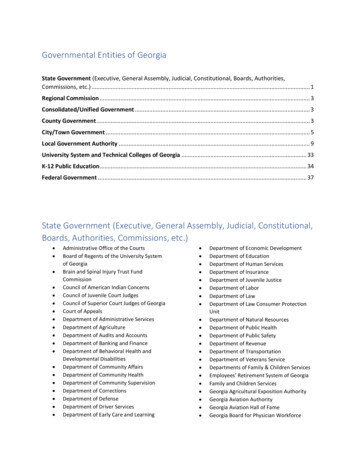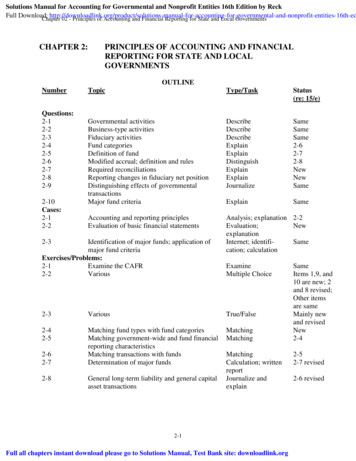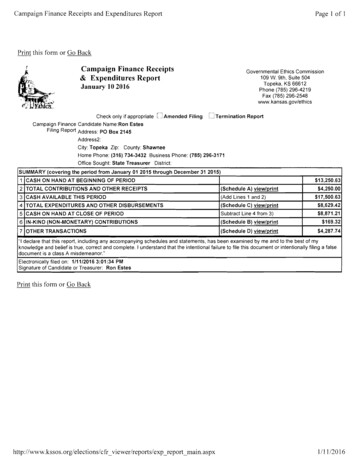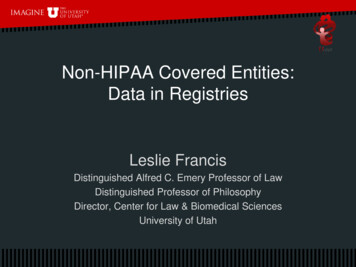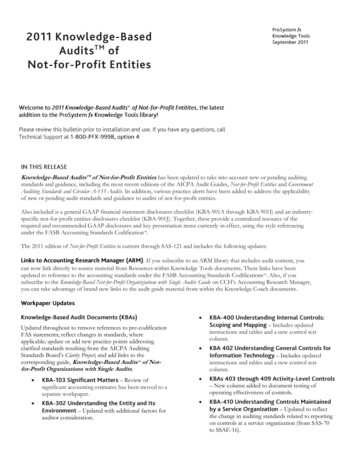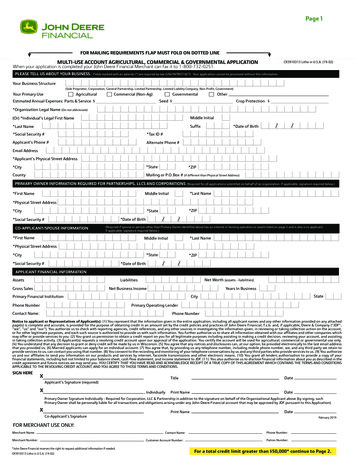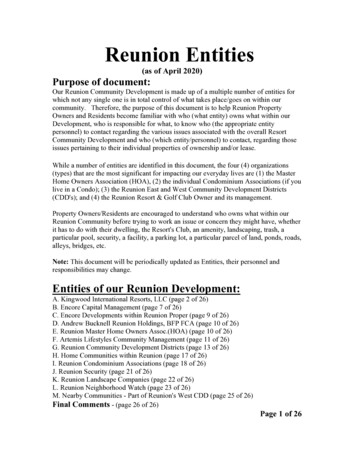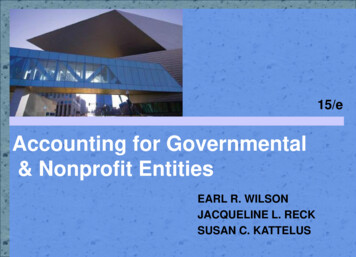
Transcription
15/eAccounting for Governmental& Nonprofit EntitiesEARL R. WILSONJACQUELINE L. RECKSUSAN C. KATTELUS1-1
Chapter1Introduction to Accounting andFinancialReporting for Governmental andNot-forProfit EntitiesMcGraw-Hill/IrwinCopyright 2010 by The McGraw-Hill Companies, Inc. All rights reserved.
Learning ObjectivesAfter studying Chapter 1, you should be able to: Identify and explain the characteristics that distinguishgovernmental and not-for-profit entities from forprofit entities Identify the authoritative bodies responsible forsetting GAAP and financial reporting standards for allgovernmental and not-for-profit organizations Contrast and compare the objectives of financialreporting for state and local governments, the federalgovernment, and not-for-profit organizations1-3
Learning Objectives (Cont’d) Explain the minimum requirements for generalpurpose external financial reporting of state and localgovernments and how they relate to comprehensiveannual financial reports Explain the different objectives, measurement focus,and basis of accounting of the government-widefinancial statements and fund financial statements ofstate and local governments1-4
What are Governmental Organizations? Generalpurpose governmentsProvide a wide variety of services Examples: Federal government, state governments,cities, towns, townships, villages, counties, boroughs,and parishes Specialpurpose governmentsUsually provide only a single or just a few services Examples: Independent school systems, public collegesand universities, public hospitals, fire protection districts,sewer districts, transportation authorities, and manyothers 1-5
What are Not-for-Profit Organizations? Legallyseparate organizations Usually exempt from federal, state, and local taxation Religious, community service, private educational andhealth care, museums, andfraternal and social organizations,among many other kinds oforganizations1-6
How Do Governmental andNot-For-Profit Organizations Differfrom Business Organizations? Resourceproviders do not expect toreceive proportional benefits Lack of a profit motive Absence of transferableownership rights1-7
How Do Governmental Entities DifferFrom Not-For-Profit Organizations? Power ultimately rests in the hands of the peoplePeople delegate power to public officials throughthe election processEmpowered by and accountable to a higher levelgovernmentTaxation powers1-8
Criteria for Determining Whetheran NPO is Governmental Public corporations and bodies corporate andpoliticOther organizations with one or more of thefollowing characteristics: Popular election of officers, or appointmentof a controlling majority of the governingbody by officials of another government Potential dissolution by a government withnet assets reverting to a government Power to enact and enforce a tax levy1-9
Sources of GAAP andFinancial Reporting Standards FASBBusiness organizationsNongovernmental not-for-profitsGASBGovernmental organizationsGovernmental not-for-profitsFASABFederal government and its agencies1-10
Why Must Governmental Financial ReportingDiffer from Business Financial Reporting? Different financial report users with differentneedsGovernmental financial reporting focuses onstewardship and accountability for how publicresources are raised and used to provideservices1-11
Objectives of Financial Reporting—Stateand Local Governments (SLG)Governmental financial reports are used primarily to: Compare actual financial results with legallyadopted budget Assess financial condition and results ofoperations Assist in determining compliance with financerelated laws, rules, and regulations Assist in evaluating efficiency and effectiveness1-12
Objectives of Financial Reporting—SLG (Cont’d)“ACCOUNTABILITY is the cornerstone of allfinancial reporting in government “ (GASBConcepts Statement No. 1, par. 56)1-13
Objectives of Financial Reporting—SLG (Cont’d)Q: What do we mean byaccountability?A: Accountability arises from citizens’“right to know” It imposes a duty onpublic officials to be accountable tocitizens for raising public monies andhow they are spent1-14
Objectives of Financial Reporting—SLG(Cont’d)Q: How does “interperiod equity” relateto accountability?A: Interperiod equity is a government’sobligation to disclose whether currentyear revenues were sufficient to pay forcurrent-year benefits—or did currentcitizens defer payments to futuretaxpayers?1-15
Objectives of Financial Reporting—Federal Government Accountability is also the foundation offederal government financial reporting Federal Accounting Standards AdvisoryBoard (FASAB) standards are targeted atboth internal users (management) andexternal users1-16
Objectives of Financial Reporting—Federal Government (Cont’d)Federal government financial reporting should assistreport users in evaluating: Budgetary integrity Operating performance Stewardship Adequacy of systems and controls1-17
Objectives of Financial Reporting—Not-for-Profit (NFP) OrganizationsNFP financial reporting should provide informationuseful in: Making resource allocation decisions Assessing services and ability to provide services Assessing management stewardship andperformance Assessing economic resources, obligations, netresources, and changes in them1-18
Minimum Requirement for GeneralPurpose External Financial ReportingManagement’s discussion and analysisGovernment-widefinancial statementsFund financialstatementsNotes to the financial statementsRequired supplementary information(other than MD&A)1-19
Fund Accounting Funds have separate self-balancing sets ofaccounts used to account for resourcessegregated for specific purposes or restrictedas to use by donors or grantorsFunds are separate accounting and fiscalentities (Chapters 2-9 provide detail)1-20
Fund AccountingFund categories: GovernmentalProprietaryFiduciary1-21
Governmental FundsCharacteristics: Focus on short-term flow of financial resources Only account for current assets and current liabilities Use modified accrual basis of accounting (revenuesrecognized when measurable and available forspending and expenditures when incurred) Closely tied to budgetary accounting1-22
Proprietary and Fiduciary FundsCharacteristics: Focus on flow of economic resources Accrual basis of accounting (revenues recognizedwhen earned and expenses when incurred) Account for both current and noncurrent assets andcurrent and noncurrent liabilities—similar tobusiness accounting1-23
Comprehensive Annual Financial Report(CAFR)Introductory sectionFinancial sectionStatistical section1-24
CAFR - Introductory Section Title pageContents pageLetter of transmittalOther (as desired bymanagement)1-25
CAFR - Financial Section Auditor’s report Basic financial statements Required supplementary information(RSI)(other than MD&A) Combining and individual fundstatements and schedules1-26
Management’s Discussion and Analysis(MD&A)Brief objective narrativeproviding management’sanalysis of the government’sfinancial performance1-27
Basic Financial StatementsGovernment-wide financial statements Statement of net assets (Illustration A1-1) Statement of activities (Illustration A1-2)1-28
Basic Financial Statements—Governmentwide Financial Statements (Cont’d)Points of interest (Ill. A1-1 and A1-2) Informationis reported separately for the primarygovernment and discretely presentedcomponent units Withinthe primary government, information isreported separately for governmental andbusiness-type activities1-29
Basic Financial Statement—Governmentwide Financial Statements (Cont’d)Points of interest (Cont’d) All financial information in the government-widefinancial statements is reported on the accrualbasis with an economic resources focus—similar to business financial reportingAssists in assessing operationalaccountability—how efficiently resources arebeing used1-30
Basic Financial Statements—FundFinancial StatementsGovernmental funds Balance sheet—governmental funds (Ill. A1-3) withreconciliation (Ill. A1-4) Statement of revenues, expenditures, and changesin fund balances—governmental funds (Ill. A1-5)with reconciliation (Ill. A1-6) These statements report information separately forthe General Fund and other major funds (Chapter 2defines major funds)1-31
Basic Financial Statements—FundFinancial Statements (Cont’d)Governmental funds—points of interest Focus on flow of current (i.e., short-term)financial resources recognized on the modifiedaccrual basis of accountingAssist in assessing fiscal accountability—whether financial resources were raised andexpended in compliance with budgetary andother legal provisions1-32
Basic Financial Statements—FundFinancial Statements (Cont’d)Governmental funds—points of interest(Cont’d) Reporting the same information aboutgovernmental activities in two different wayscreates a need to reconcile the informationreported in the governmental fund financialstatements to that in the GovernmentalActivities Column of the government-widestatements (see Illustrations A1-4 and A1-6)1-33
Basic Financial Statements—FundFinancial Statements (Cont’d)Proprietary funds Statement of net assets—proprietary funds(Ill. A1-7)Statement of revenues, expenses, andchanges in fund net assets—proprietary funds(Ill. A1-8)Statement of cash flows—proprietary funds(Ill. A1-9)1-34
Basic Financial Statements—FundFinancial StatementsProprietary funds—points of interest Reports information for enterprise funds andinternal service funds using an economicresources focus and accrual basis of accounting Information is reported in separate columns formajor enterprise funds. All internal service fundinformation reported is combined in a singlecolumn1-35
Basic Financial Statements—FundFinancial Statements (Cont’d)Fiduciary funds Statement of fiduciary net assets (Ill. A1-10) Statement of changes in fiduciary net assets(Ill. A1-11)1-36
Basic Financial Statements—FundFinancial Statements (Cont’d)Fiduciary funds—points of interest Fiduciary activities relate to the government’sresponsibility as an agent or trustee to holdand/or manage resources for the benefit ofprivate partiesSince fiduciary resources cannot be used bythe government, they are reported only in thefiduciary fund financial statements—not in thegovernment-wide statements1-37
CAFR - Statistical SectionTables and chartsshowing multiple-yeartrends in financial andsocio-economicinformation (discussed indetail in Chapter 9)1-38
Concluding Comments In this course you will become familiar withcurrent GASB, FASB, and FASAB standardsrelative to governmental and not-for-profitorganizations Accounting and reporting for governmental andnot-for-profit entities differ from those of forprofit entities because each type of entity hasdifferent purposes and reporting objectives1-39
A Quote from the Original Author“.Even when developed to the ultimate stage ofperfection, governmental accounting cannotbecome a guaranty of good government. Atbest, it can never be more than a valuable toolfor promotion of sound financial management.”Professor R. M. Mikesell, 1951END1-40
1-1 EARL R. WILSON JACQUELINE L. RECK SUSAN C. KATTELUS Accounting for Governmental & Nonprofit Entities 15/e
